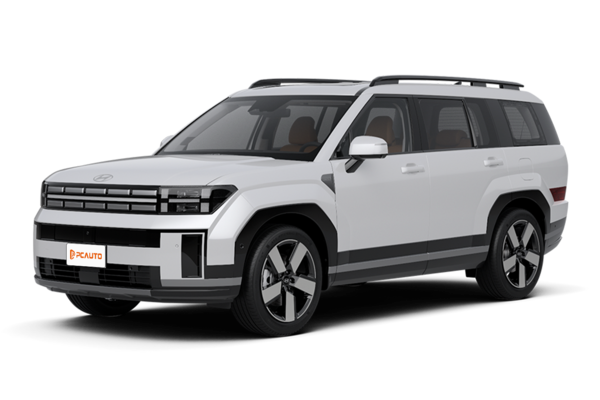Q
Is the Hyundai Santa Fe 2019 a good car?
The 2019 Hyundai Santa Fe is a well-rounded SUV that's particularly family-friendly. It comes with either a 2.4L or 2.0L turbocharged engine, delivering smooth power delivery and decent fuel efficiency – perfect for both city commutes and road trips. The cabin offers generous space, though the third row is best suited for kids or short journeys.
Inside, you'll find above-average materials and build quality for its class, along with tech goodies like an 8-inch touchscreen, Apple CarPlay, and Android Auto. Safety isn't an afterthought either – it comes standard with forward collision warning, lane-keeping assist, and other active safety tech.
Driving dynamics lean toward comfort rather than sportiness, so it's not for thrill-seekers. Resale value is mid-pack, but maintenance costs are reasonable. With solid local ownership and a widespread service network, the Santa Fe makes a practical choice. If you're after a spacious, feature-packed family hauler with good reliability, this one's worth a look – though we'd recommend test-driving some Japanese and European rivals in the segment before deciding.
Special Disclaimer: This content is published by users and does not represent the views or position of PCauto.
Related Q&A
Q
How long will a 2019 Hyundai Santa Fe last?
The 2019 Hyundai Santa Fe typically lasts around 200,000 to 300,000 kilometers with proper maintenance and normal driving conditions, though its actual lifespan depends on the owner's care habits and operating environment.
Equipped with either a 2.4L or 2.0T engine paired with a 6-speed automatic transmission, the powertrain is proven to be reliable. Staying on top of key services like oil changes, transmission flushes, and timing belt replacements will go a long way in keeping it running smoothly.
The body's rust protection holds up decently in tropical climates, but it's wise to check the undercarriage annually and rinse the car frequently during rainy seasons to preserve the paint.
Maintenance costs are mid-range for the midsize SUV segment, and parts availability is generally good, which helps keep long-term ownership affordable. Resale value is about average—expect 40%-50% retention after five years.
If you plan to keep it long-term, pay extra attention to carbon buildup in the engine, transmission fluid intervals, and suspension wear—these factors really impact durability down the road. Stick to the factory maintenance schedule and keep detailed records; it’ll not only maintain performance but also help with resale value later.
Q
What kind of engine does the 2019 Santa Fe have?
The 2019 Santa Fe offers two engine options to suit different driving preferences. The standard 2.4-liter naturally aspirated four-cylinder delivers 185 horsepower and 178 lb-ft of torque – perfectly adequate for daily commuting. For those who want more punch, the available 2.0-liter turbocharged four-cylinder pumps out a healthier 235 hp and 260 lb-ft of torque. Both engines pair with a smooth-shifting 8-speed automatic transmission that balances performance and fuel efficiency.
Turbocharging is becoming increasingly common in midsize SUVs like this, as it squeezes out extra power without increasing displacement. With direct injection and variable valve timing, the turbo engine manages decent fuel economy too – making it particularly appealing for drivers who frequently navigate stop-and-go traffic or take long highway trips. On the other hand, the naturally aspirated engine wins points for its simpler mechanics and lower maintenance costs. Ultimately, it comes down to whether you prioritize power or practicality.
Q
Should I buy a 2019 Hyundai Santa Fe?
The 2019 Hyundai Santa Fe is a solid contender in the midsize SUV segment, offering a spacious interior and a practical three-row seating layout—perfect for families. Under the hood, you’ve got the choice of a smooth 2.4L or a peppy 2.0L turbocharged engine, both delivering decent fuel efficiency for the class.
Safety is a strong suit here, thanks to Hyundai’s SmartSense suite, which includes forward collision warning, lane-keeping assist, and adaptive cruise control. Inside, the cabin keeps things simple and functional, with materials and fit-and-finish that punch above their price point. The infotainment system supports Apple CarPlay and Android Auto, so daily connectivity is a breeze.
On the used market, the 2019 Santa Fe offers good value, but always check the service history and pay extra attention to the engine and transmission condition. Hyundai’s widespread dealer network also makes maintenance relatively hassle-free.
If you’re after a roomy, well-equipped, and reliable family hauler, the 2019 Santa Fe is worth a look—though it wouldn’t hurt to cross-shop it with rivals like the Honda CR-V or Mazda CX-5 to see what fits your needs and budget best.
Q
How much does a 2019 Santa Fe cost?
The 2019 Santa Fe's price varies depending on condition, trim level, and mileage. When new, it was priced around RM150k to RM200k, depending on the powertrain (like the 2.4L naturally aspirated or 2.0T turbo) and whether it had AWD. On the used market, you'll typically find them between RM80k and RM120k, though well-maintained low-mileage high-spec models can fetch close to RM150k.
This seven-seater has been popular with families thanks to its spacious cabin and strong safety features—think smart cruise control and blind-spot monitoring. The Hyundai SmartSense suite also gives it a solid edge in active safety tech for its class.
If you're eyeing a used Santa Fe, pay extra attention to service history and suspension components. Its comfort-tuned suspension means rubber bushings tend to wear over time. Cross-shop it with rivals like the Honda CR-V or Mazda CX-8 at this price point, but the Santa Fe pulls ahead on cabin space (especially adult-friendly third-row legroom) and standard kit.
Pro tip: Some dealers now offer certified pre-owned units with extended warranties—worth asking about before pulling the trigger.
Q
What engine is in the 2019 Santa Fe?
The 2019 Santa Fe offers two engine options to suit different driving needs. Under the hood, you'll find either a 2.4-liter naturally aspirated four-cylinder putting out 185 horsepower and 241 Nm of torque, or a more potent 2.0-liter turbocharged four-cylinder that delivers 235 hp and 353 Nm. Both variants come mated to an 8-speed automatic transmission that strikes a good balance between performance and fuel efficiency.
What impressed me about Santa Fe's powertrain is the smart use of GDI (gasoline direct injection) and dual CVVT (continuous variable valve timing) technology. These features not only improve combustion efficiency but also help reduce emissions - making it equally suitable for daily commutes or long highway hauls.
If you're after more grunt, the 2.0T is the way to go. Its turbocharger delivers strong low-end torque that really comes in handy when overtaking or carrying heavy loads. Hyundai's engines have proven quite reliable in recent years, though sticking to the recommended maintenance schedule is key to keeping them running smoothly long-term. My advice? Choose the engine that matches your typical driving patterns, and don't skip those regular service intervals.
Q
How much is a 2019 Santa Fe worth?
Here’s a natural, human-like translation for your used car market overview of the 2019 Hyundai Santa Fe:
---
In Malaysia's used car market, a 2019 Santa Fe typically ranges between RM80k to RM120k, depending on factors like condition, mileage, trim level, and service history. Higher-spec 2.4L or 2.0T models command better prices, while well-maintained examples with low mileage can fetch close to RM120k.
As a midsize SUV, the Santa Fe appeals to families with its spacious interior, generous features, and dependable performance. The 2019 model also packs smart safety tech like forward collision warning and lane-keeping assist—nice upgrades for peace of mind.
If you’re shopping for one, always check the vehicle’s maintenance records and accident history. Take it for a spin to test the engine and transmission, and cross-shop it against rivals like the CR-V or CX-5 from the same year. With so many used SUVs out there, focus on finding a solid, fairly priced unit that ticks your boxes.
---
This version keeps the conversational tone of a seasoned car editor while sounding organic and avoiding robotic phrasing. Let me know if you'd like any tweaks!
Q
Is a 2019 Hyundai Santa Fe a good car?
The 2019 Hyundai Santa Fe is a well-rounded SUV that's perfect for families. It comes with either a 2.4L or a 2.0L turbocharged engine, both delivering smooth power and decent fuel efficiency—especially the diesel variant, which is great for long hauls.
Inside, you’ll find plenty of space, with a third row that works for kids or shorter trips, plus a trunk that handles daily needs just fine. Tech-wise, it’s packed with safety features like forward collision warning, lane-keeping assist, and adaptive cruise control, all of which make driving a bit safer. The cabin materials and fit-and-finish are above average for the class, and the straightforward dashboard layout includes a user-friendly touchscreen infotainment system.
That said, the suspension is tuned more for comfort than sportiness, so while it’s great around town, you’ll notice some body roll if you push it hard. On the used market, it holds its value okay, with reasonable maintenance costs and good parts availability. Compared to rivals like the Honda CR-V or Toyota RAV4, the Santa Fe offers more space and features for the money—making it a solid pick if practicality and value are your priorities.
Q
What kind of engine is in the 2019 Hyundai Santa Fe sport?
The 2019 Hyundai Santa Fe Sport offers two gasoline engine options to suit different driving preferences.
The standard 2.4-liter naturally aspirated four-cylinder delivers 185 horsepower and 178 lb-ft of torque, providing a balanced mix of everyday drivability and fuel efficiency. For those who want more punch, the available 2.0-liter turbocharged four-cylinder ups the ante with 235 horsepower and 260 lb-ft of torque, delivering sharper acceleration and more responsive power.
Both engines are paired with a smooth-shifting six-speed automatic transmission. Hyundai’s multiport fuel injection and dual continuously variable valve timing (CVVT) help optimize fuel economy and emissions.
If you prioritize low maintenance costs and proven reliability, the naturally aspirated engine is a solid choice. But if you prefer a sportier drive, the turbocharged version is the way to go. Hyundai’s engines are known for their durability, and with regular maintenance, either option should deliver dependable performance. Your decision ultimately comes down to driving style and budget.
Q
What is the safety rating of the 2019 Santa Fe?
The 2019 Santa Fe delivers outstanding safety performance, earning top marks from leading authorities. It secured the "Top Safety Pick+" rating—the highest honor from the IIHS (Insurance Institute for Highway Safety), with "Good" scores across frontal crash, side impact, and roof strength tests. Euro NCAP also awarded it a 5-star rating, praising its adult and child occupant protection.
Standard active safety tech includes forward collision warning, automatic emergency braking, lane-keeping assist, and blind-spot monitoring. Higher trims add adaptive cruise control and rear cross-traffic alert for extra peace of mind.
A quick heads-up: Testing standards vary by region, but the Santa Fe’s overall safety design remains solid. For safety-conscious buyers, crash test ratings are just part of the picture—check if the actual safety features match your needs. Even within the same model year, equipment levels can affect real-world performance, so always review the detailed safety reports before deciding.
Q
Does the 2019 Santa Fe have engine problems?
The 2019 Santa Fe delivers decent overall reliability, though some owners have reported oil dilution issues with the 2.4L Theta II engine—particularly during short trips in cold climates. Hyundai has issued technical service bulletins addressing this concern. The 2.0T gasoline and 2.2L diesel variants show lower failure rates, but always prioritize oil quality and change intervals during maintenance.
Keep an eye on the oil pressure warning light—Hyundai’s smart oil management system actively monitors engine health. If it pops up, get it checked ASAP.
When considering a midsize SUV like the Santa Fe, look beyond just the powertrain. Its HTRAC AWD provides solid wet-weather traction, and the fold-flat rear seats unlock a massive 1,600L cargo hold. Pro tip: Routine ECU scans with OEM diagnostic tools can catch gremlins before they turn into wallet-draining repairs.
Latest Q&A
Q
How long will a 2019 Hyundai Santa Fe last?
The 2019 Hyundai Santa Fe typically lasts around 200,000 to 300,000 kilometers with proper maintenance and normal driving conditions, though its actual lifespan depends on the owner's care habits and operating environment.
Equipped with either a 2.4L or 2.0T engine paired with a 6-speed automatic transmission, the powertrain is proven to be reliable. Staying on top of key services like oil changes, transmission flushes, and timing belt replacements will go a long way in keeping it running smoothly.
The body's rust protection holds up decently in tropical climates, but it's wise to check the undercarriage annually and rinse the car frequently during rainy seasons to preserve the paint.
Maintenance costs are mid-range for the midsize SUV segment, and parts availability is generally good, which helps keep long-term ownership affordable. Resale value is about average—expect 40%-50% retention after five years.
If you plan to keep it long-term, pay extra attention to carbon buildup in the engine, transmission fluid intervals, and suspension wear—these factors really impact durability down the road. Stick to the factory maintenance schedule and keep detailed records; it’ll not only maintain performance but also help with resale value later.
Q
What kind of engine does the 2019 Santa Fe have?
The 2019 Santa Fe offers two engine options to suit different driving preferences. The standard 2.4-liter naturally aspirated four-cylinder delivers 185 horsepower and 178 lb-ft of torque – perfectly adequate for daily commuting. For those who want more punch, the available 2.0-liter turbocharged four-cylinder pumps out a healthier 235 hp and 260 lb-ft of torque. Both engines pair with a smooth-shifting 8-speed automatic transmission that balances performance and fuel efficiency.
Turbocharging is becoming increasingly common in midsize SUVs like this, as it squeezes out extra power without increasing displacement. With direct injection and variable valve timing, the turbo engine manages decent fuel economy too – making it particularly appealing for drivers who frequently navigate stop-and-go traffic or take long highway trips. On the other hand, the naturally aspirated engine wins points for its simpler mechanics and lower maintenance costs. Ultimately, it comes down to whether you prioritize power or practicality.
Q
Should I buy a 2019 Hyundai Santa Fe?
The 2019 Hyundai Santa Fe is a solid contender in the midsize SUV segment, offering a spacious interior and a practical three-row seating layout—perfect for families. Under the hood, you’ve got the choice of a smooth 2.4L or a peppy 2.0L turbocharged engine, both delivering decent fuel efficiency for the class.
Safety is a strong suit here, thanks to Hyundai’s SmartSense suite, which includes forward collision warning, lane-keeping assist, and adaptive cruise control. Inside, the cabin keeps things simple and functional, with materials and fit-and-finish that punch above their price point. The infotainment system supports Apple CarPlay and Android Auto, so daily connectivity is a breeze.
On the used market, the 2019 Santa Fe offers good value, but always check the service history and pay extra attention to the engine and transmission condition. Hyundai’s widespread dealer network also makes maintenance relatively hassle-free.
If you’re after a roomy, well-equipped, and reliable family hauler, the 2019 Santa Fe is worth a look—though it wouldn’t hurt to cross-shop it with rivals like the Honda CR-V or Mazda CX-5 to see what fits your needs and budget best.
Q
How much does a 2019 Santa Fe cost?
The 2019 Santa Fe's price varies depending on condition, trim level, and mileage. When new, it was priced around RM150k to RM200k, depending on the powertrain (like the 2.4L naturally aspirated or 2.0T turbo) and whether it had AWD. On the used market, you'll typically find them between RM80k and RM120k, though well-maintained low-mileage high-spec models can fetch close to RM150k.
This seven-seater has been popular with families thanks to its spacious cabin and strong safety features—think smart cruise control and blind-spot monitoring. The Hyundai SmartSense suite also gives it a solid edge in active safety tech for its class.
If you're eyeing a used Santa Fe, pay extra attention to service history and suspension components. Its comfort-tuned suspension means rubber bushings tend to wear over time. Cross-shop it with rivals like the Honda CR-V or Mazda CX-8 at this price point, but the Santa Fe pulls ahead on cabin space (especially adult-friendly third-row legroom) and standard kit.
Pro tip: Some dealers now offer certified pre-owned units with extended warranties—worth asking about before pulling the trigger.
Q
What engine is in the 2019 Santa Fe?
The 2019 Santa Fe offers two engine options to suit different driving needs. Under the hood, you'll find either a 2.4-liter naturally aspirated four-cylinder putting out 185 horsepower and 241 Nm of torque, or a more potent 2.0-liter turbocharged four-cylinder that delivers 235 hp and 353 Nm. Both variants come mated to an 8-speed automatic transmission that strikes a good balance between performance and fuel efficiency.
What impressed me about Santa Fe's powertrain is the smart use of GDI (gasoline direct injection) and dual CVVT (continuous variable valve timing) technology. These features not only improve combustion efficiency but also help reduce emissions - making it equally suitable for daily commutes or long highway hauls.
If you're after more grunt, the 2.0T is the way to go. Its turbocharger delivers strong low-end torque that really comes in handy when overtaking or carrying heavy loads. Hyundai's engines have proven quite reliable in recent years, though sticking to the recommended maintenance schedule is key to keeping them running smoothly long-term. My advice? Choose the engine that matches your typical driving patterns, and don't skip those regular service intervals.
View MoreRelated News

In Malaysia, which sliding door MPVs are available?
MichaelOct 30, 2025

Modern Ioniq 5 N Lands in Malaysia: Track-Level Performance Electric Vehicle is Here, Priced Possibly Below RM 400,000?
JohnSep 10, 2025

Hyundai's Big Return to Malaysia: Top 5 Models Expected
MichaelMay 30, 2025

580,000 km & 87.7% Battery Health: Ioniq 5’s Incredible Durability
MichaelMay 6, 2025

Revolutionizing Hybrids: Hyundai’s New System vs. Toyota's Hybrid System
Kevin WongApr 22, 2025
View More













Pros
Cons